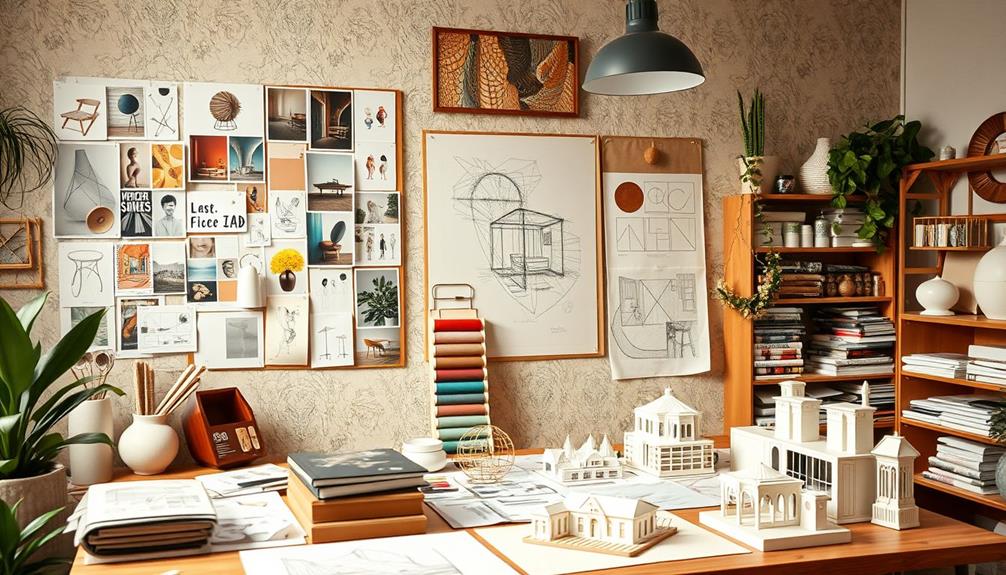Creating an interior design portfolio starts with understanding its purpose—showcase your style and skills. Choose a format that suits you, like a digital or physical portfolio. Select your best 5-7 projects, using high-quality images and brief narratives to explain your concepts and solutions. Highlight your design process with sketches and mood boards to document your journey. Incorporate client testimonials to validate your expertise. Finally, share your work effectively through social media and online platforms. Remember, your portfolio should evolve with your work and the industry trends, paving the way for exciting opportunities ahead. To keep your interior design portfolio up-to-date, regularly add new projects that reflect your growth and expertise. Consider including before-and-after photos to showcase the transformative power of your designs. Additionally, seek feedback from colleagues and mentors to continually improve your portfolio. By continuously honing your interior design portfolio, you can position yourself as a sought-after professional in the industry. Consider including a variety of project types in your portfolio to demonstrate your versatility as a designer. Whether it’s residential, commercial, or hospitality projects, showcasing a range of styles and spaces will appeal to a wider audience. Furthermore, don’t underestimate the power of storytelling in your portfolio. Use your narratives to convey the thought process behind each project and the unique challenges you’ve overcome. By incorporating these interior design tips into your portfolio, you can effectively communicate your talent and expertise to potential clients and employers.
Key Takeaways
- Choose a suitable format for your portfolio, such as digital, physical, or online platforms, to effectively showcase your work.
- Select 5-7 of your best projects, using high-quality images and brief narratives to illustrate your design concepts and problem-solving skills.
- Document your design process by including sketches, mood boards, and milestones, highlighting the evolution of your ideas into final designs.
- Incorporate client feedback and testimonials to validate your expertise and enhance your portfolio's credibility and appeal.
- Utilize social media and online platforms for sharing your portfolio, engaging with audiences, and keeping your work updated and relevant.
Understanding Portfolio Purpose
When it comes to building your interior design portfolio, understanding its purpose is essential. Your portfolio serves as a professional showcase of your unique design style and skills, helping you attract potential clients and employers in a competitive market. It clarifies your design philosophy, enabling you to communicate your approach and thought process more effectively than social media ever could.
A well-organized interior designer portfolio reflects your personal branding, establishing your identity and setting you apart from competitors. It's not just a collection of images; it's a curated body of work that illustrates your versatility and adaptability—qualities that design firms and clients highly value.
Your portfolio website allows for ongoing evolution, so you can include new projects and styles over time, ensuring your work remains relevant and engaging. By showcasing a thoughtful selection of projects, you can demonstrate your skills and the breadth of your experience.
Choosing the Right Format

Your portfolio's format plays a significant role in how effectively you present your work. Selecting the right format can enhance engagement and showcase your design style. Here are three options to take into account:
- Digital Portfolios: These are convenient and easily shared across devices, allowing you to reach a wider audience. They also enable you to include interactive elements like videos and 3D models for a richer experience.
- Physical Portfolios: While they might take more effort to create, physical portfolios can leave a lasting impression during in-person presentations. You can incorporate tangible materials and even add QR codes for instant access to your digital content.
- Online Platforms: Utilizing platforms like Behance or your personal website can help you create an interactive portfolio. This allows for a cohesive visual presentation that harmonizes with your personal brand while showcasing your latest work.
Whichever format you choose, make certain to regularly update it to reflect your latest work and industry trends.
Keeping your portfolio fresh guarantees it stays relevant to potential clients and employers.
Showcasing Your Best Work

Often, showcasing your best work is vital for making a strong impression on potential clients or employers. To create a successful interior design portfolio, select only your top 5-7 projects. This approach guarantees clarity and impact while demonstrating your design skills across a variety of project types, such as residential and commercial spaces.
For inspiration on innovative design ideas, explore exclusive design insights that can elevate your portfolio.
Use high-quality images that present your work in the best light. Focus on proper lighting, composition, and resolution to enhance visual appeal. Each photo should capture the essence of your design, allowing potential clients to envision your style and capabilities.
Don't forget to include a brief narrative for each project. Explain the design concept, challenges you faced, and solutions you implemented. This context not only highlights your creativity but also showcases your problem-solving skills, which is vital for clients seeking a designer who can adapt to their needs.
Lastly, regularly update your portfolio with new work and remove outdated projects. This keeps your portfolio relevant and guarantees you're always showing your best work.
Highlighting Your Design Process

To effectively highlight your design process, start by providing a clear overview of the design brief for each project.
This sets the stage for showcasing your visual documentation, like sketches and mood boards, that illustrate your creative journey.
Design Brief Overview
A compelling design brief acts as the foundation of your interior design portfolio, setting the stage for each project. It outlines your clients' needs, objectives, and constraints, establishing the context for your design choices.
Here's what clients love about a well-crafted design brief:
- Clear Objectives: It highlights the primary goals, ensuring everyone's on the same page from the start.
- Visual Elements: Incorporate sketches, mood boards, and concept diagrams to illustrate your initial design concepts and the creative process behind your work.
- Milestones and Reflection: Showcase key milestones throughout your design journey, demonstrating how ideas evolved into final designs.
Conclude with a reflection on outcomes, discussing successes, challenges, and lessons learned.
Visual Process Documentation
Visual process documentation is essential in showcasing your design journey and illustrating the evolution of your ideas. By including various visual elements, like sketches, mood boards, and color palettes, you can effectively document the design process from initial concepts to the final execution. High-quality images or renderings of each project phase really help emphasize the transformation and thought behind your work.
As you compile your portfolio, make sure to document the design process step-by-step. Include client briefs, preliminary sketches, and iterations to provide context for your final designs. This not only highlights your creativity but also showcases your problem-solving skills.
Incorporating Feedback and Testimonials

Incorporating feedback and testimonials is essential for showcasing your design expertise and building trust with potential clients. By actively seeking insights from clients and peers after project completion, you can highlight your strengths and pinpoint areas for improvement.
Here are three effective ways to integrate feedback and testimonials into your design portfolio:
- Direct Inclusion: Incorporate testimonials directly into your portfolio. This validates your design expertise and showcases positive client experiences that can heavily influence potential clients' decisions.
- Visually Engaging Layout: Use short quotes alongside project images to create a visually engaging layout. This emphasizes your successes while maintaining a clean, attractive presentation.
- Regular Updates: Regularly update your portfolio with fresh testimonials to reflect your most recent work. This guarantees your design portfolio remains relevant and appealing to prospective employers or clients.
Additionally, consider leveraging online platforms to collect and manage client testimonials efficiently. This makes it easier to include them in both digital and printed versions of your portfolio.
Effective Sharing Strategies

To effectively share your interior design portfolio, you need to utilize online platforms and social media to reach a broader audience.
Consider creating a professional website that acts as a hub for your work, while engaging with potential clients through networks like Instagram and Pinterest.
Online Portfolio Platforms
An effective online portfolio is essential for showcasing your interior design work and attracting potential clients. Choosing the right platform can make a significant difference in how you present your skills. For instance, implementing effective keyword clustering can enhance your portfolio's discoverability.
Here are three platforms to evaluate:
- Behance and Adobe Portfolio: These cater specifically to creatives, allowing for easy customization and professional presentation of your work.
- Squarespace or Wix: Both offer templates designed for showcasing portfolios, with the added benefit of e-commerce features if you want to sell design software or products.
- Social Media: Platforms like Instagram and Pinterest are perfect for sharing snippets of your portfolio. Use relevant hashtags to show people your designs and increase visibility.
Additionally, think about using cloud storage solutions, like Google Drive or Dropbox, to share high-resolution images and project files with potential employers.
Regularly update your online portfolio to reflect your most recent work and stay in tune with industry trends. A good portfolio not only highlights your talent but also keeps your audience engaged and interested in your unique style.
Networking and Outreach
Networking is essential for interior designers looking to expand their reach and attract clients. To effectively share your portfolio, leverage social media platforms like Instagram and Pinterest. These platforms allow you to share visually appealing snippets of your work, reaching a broader audience and drawing in potential clients.
Engaging with your audience through fun hangout ideas can also create a more personal connection, making them more likely to remember your designs.
In-person interactions also matter, so attend design networking events and workshops. Present your work directly to industry professionals, fostering meaningful connections that can lead to future opportunities.
Consider using online portfolio platforms like Behance or your own website for easy access to your designs, making it simple for prospective employers and clients to view and share your work.
Don't forget the power of business cards. Create cards featuring your portfolio link and QR codes, enabling quick access and facilitating follow-ups after networking events.
Regularly engage with your network by sharing updates on new projects and design trends through newsletters or social media. This keeps you top-of-mind and helps maintain those valuable connections.
Social Media Engagement
In today's digital landscape, social media serves as a powerful tool for showcasing your interior design portfolio and engaging potential clients. To maximize your social media engagement, consider these effective sharing strategies:
1. Utilize Visual Platforms: Focus on visually appealing platforms like Instagram and Pinterest to showcase your work. Research shows that 80% of users engage more with visual content than text-based posts.
Incorporating images of stylish wall clocks or enchanting pendant lights can create a strong visual impact and draw attention to your design aesthetics. For inspiration, check out stylish wall clocks.
2. Consistent Posting Schedule: Create one by posting regularly. Brands that maintain a schedule see 2.5 times more engagement than those that don't.
3. Use Relevant Hashtags: Employ hashtags like #InteriorDesign and #HomeDecor to increase visibility. Posts with at least one hashtag can experience up to 12.6% more engagement.
Additionally, don't forget to share behind-the-scenes content, including sketches and mood boards, to humanize your brand and foster follower loyalty.
Collaborating with influencers or other interior designers can also amplify your reach, potentially leading to a 3-5 times increase in audience engagement.
Conclusion
Creating a standout interior design portfolio is essential for capturing potential clients' attention. Did you know that 78% of hiring managers prefer a well-organized portfolio over a resume alone? By showcasing your best work, highlighting your design process, and incorporating testimonials, you're not just presenting designs; you're telling a story. Remember, the right format and effective sharing strategies will guarantee your portfolio gets the recognition it deserves. So, get started and let your creativity shine!








